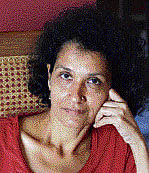'Will anyone take Aruna's place?'

Her very first book ‘Aruna’s Story’ (1998) was hailed as path-breaking and continues to be read by gender-study collegiates. Her another book ‘Bitter Chocolate’ (2000) on child sexual abuse in middle and upper-class homes opened a new genre and earned her international plaudit for being the first in the Indian subcontinent to courageously speak up as a victim of incest. She won national award for that book.
Born in a Mumbai chawl in its Dongri area, Pinki Virani (52) began working as a typist at the age of 18. In journalism she began as reporter for a newspaper, worked as special correspondent for a national weekly, launched a fortnightly city magazine as editor and is India’s first woman editor of an eveninger.
Following are excerpts of an interview to Deccan Herald:
How did you come to know Aruna Shanbaug?
I came to know about Aruna and her tragic plight from my mother 27 years back. My mother told me Aruna’s story which she had heard from her social worker friends; she then recalled reading the news-report about the crime when it had occurred. I was deeply touched and moved when I learnt about Aruna’s state. I went and saw her in the hospital and thereafter frequently visited her, taking small things for her like idli-sambhar and fish curry-rice which could be mashed and fed to her. I stopped taking fresh fruit juice as Aruna could not swallow on her own and would start choking. I would sit there, talk to her, sing to her. She used to recognise my voice and would ‘talk’ back, grunting, cooing, sometimes what sounded like childlike complaining and gurgling. As time passed, between the early 1980s and late 1980s, Aruna’s will and spirit drained away. She would occasionally reward me with a crooked half-smile.
What do you think of the Supreme Court's judgement?
Because of Aruna Shanbaug case, the Supreme Court has permitted passive euthanasia. Which means that because of this woman who has never received justice, no other Indian in a similar position will have to suffer for more than three and a half decades.
This is the most surreal part of Aruna’s ongoing tragedy. Because this also means that Aruna’s state will worsen with persistent diarrhoea as her body cannot handle much of what is being fed through a pipe. There is no catheter to remove body fluids and waste matter which get excreted on their own. There are lengthening response times due to a ‘sinking’. She is in a permanent vegetative state; this medically means she will laugh, shriek, cry, smile for no reason at all. It will not be a response to food or people or music. Add to this the horror of feeling pain, being cortically blind, bed-ridden, no control over physical movements. Is there anybody in this country, or in this world, least of all those who claim to “love” her and want her to “live” because she has no bed-sores, wanting to exchange places with her?
Were you expecting the Supreme Court's dismissal of your petition?
I had to do right for Aruna. I had to do something to relieve her from her constant pain. I spent a lot of time talking to legal luminaries before I decided that I would move court on behalf of Aruna. So I took the role of her “next friend” which is legally permissible if a person cannot move a court themselves. I asked for a definition of the Right to live with dignity as enshrined under Article 21 of the Constitution. And I pleaded with the court that if it found Aruna was not living with dignity, her force-feeding should be stopped. As you know, there is only a pipe to her stomach, because of which she gets frequent stomach upsets. So it would have been only a matter of systematically lessening her feed over a period of time, while adding some pain-management - which is denied to her.
I didn’t go with the words “euthanasia” or “dismissal” in my head to the Supreme Court. I went with Aruna Shanbaug in my heart.
After the SC judgement, the nurses at KEM shouted slogans against you.
Civil society has already voiced its contempt and condemnation. Letters to the editor in newspapers, as also tweets on twitter, have pointed out that had the Aruna Shanbaug case not been heard by the SC, those who claim to "love" her and so she must "live" would not have received the national attention they have.
You are so close to Aruna Shanbaug for so long. What do you think could be going on in her mind, if at all one wants to speculate?
One must not speculate because our poor, poor Aruna's brain, after the extensive brain-stem damage, has shrunk substantially. Plus she is in a persistent vegetative state. I went to the Supreme Court because the one-year of research I did on Aruna - talking to her friends, relatives, then-fiancee, other doctors who remembered her, matrons and nurses of that time and also visiting her village - made it crystal-clear that she would never have wanted this sub-human existence for herself. God forbid, that those who have condemned her to continue suffering should ever go through even one per cent of what is happening to Aruna.
The catholic church is vehemently opposed to mercy killing.
The Supreme Court is that of a free, democratic, secular country. With its ruling allowing passive euthanasia in select patients, it has given every Indian - irrespective of religion - a choice.
